The Venn diagrams on two and three sets are illustrated above. The order-two diagram (left) consists of two intersecting circles, producing a total of four regions,
Examples:
- Out of forty students, 14 are taking English Composition and 29 are taking Chemistry. If five students are in both classes, how many students are in neither class? How many are in either class? What is the probability that a randomly-chosen student from this group is taking only the Chemistry class?
- There are two classifications in this problem: English students and Chemistry students.
| First, draw the square representing forty students, with two overlapping circles labelled with the total in each: | 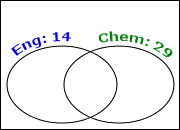 |
| Since five students are taking both classes, put "5" in the center: |  |
| Since five of the 14 English students also take Chemistry, leaving nine students taking English but not Chemistry, so put "9" in the "English only" part of the "English" circle: |  |
| Five out of the 29 Chemistry students also take English, leaving 24 students taking Chemistry but not English, so put "24" in the "Chemistry only" part of the "Chemistry" circle: | 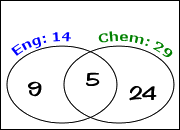 |
| Therefore, a total of 9 + 5 + 24 = 38 students are in either English or Chemistry (or both). This leaves two students unaccounted for, so they must be the ones taking neither class. | 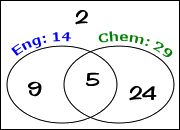 |
- Two students are taking neither class. There are 38 students in at least one of the classes. There is a 24/40 = 0.6 = 60% probability that a randomly-chosen student in this group is taking Chemistry but not English.
- Suppose I discovered that my cat had a taste for the adorable little geckoes that live in the bushes and vines in my yard, back when I lived in Arizona. In one month, suppose he deposited the following on my carpet: six gray geckoes, twelve geckoes that had dropped their tails in an effort to escape capture, and fifteen geckoes that he'd chewed on a little. Only one of the geckoes was gray, chewed on, and tailless; two were gray and tailless but not chewed on; two were gray and chewed on but not tailless. If there were a total of 24 geckoes left on my carpet that month, and all of the geckoes were at least one of "gray", "tailless", and "chewed on", how many were tailless and chewed on but not gray? If we work through this step-by-step, using what the given details above, we can figure out what we need in order to answer the question. This is a problem that takes some time and a few steps to solve.
| There was one gecko that was gray, tailless, and chewed on, so draw the Venn diagram with three overlapping circles, and put "1" in the center overlap: | 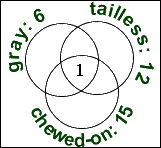 |
| Two were gray and tailless but not chewed on, so "2" goes in the rest of the overlap between "gray" and "tailless". | 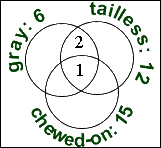 |
| Two were gray and chewed on but not tailless, so "2" goes in the rest of the overlap between "gray" and "chewed-on". | 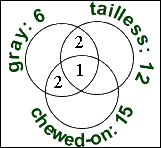 |
| Since a total of six were gray, and since 2 + 1 + 2 = 5 have already been accounted for, this means there was only one left that was only gray. | 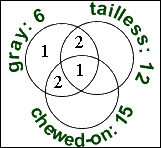 |
This leaves us needing to know how many were tailless and chewed on but not gray, which is what the problem asks for. Since we don't know how many were only chewed on or only tailless, we cannot figure out the answer yet. | |
| Let "x" stand for this unknown number of tailless, chewed-on geckoes. | 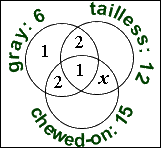 |
| The total number of chewed geckoes (15) and the total number of tailless geckoes (12) were given. Therefore: only chewed on: 15 – 2 – 1 – x = 12 – x | 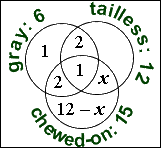 |
| only tailless: 12 – 2 – 1 – x = 9 – x | 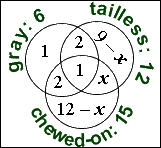 |
- 1 + 2 + 1 + 2 + x + (12 – x) + (9 – x) = 27 – x = 24
Test your understanding by answering this activity.
Sources:









0 people rectified:
Post a Comment